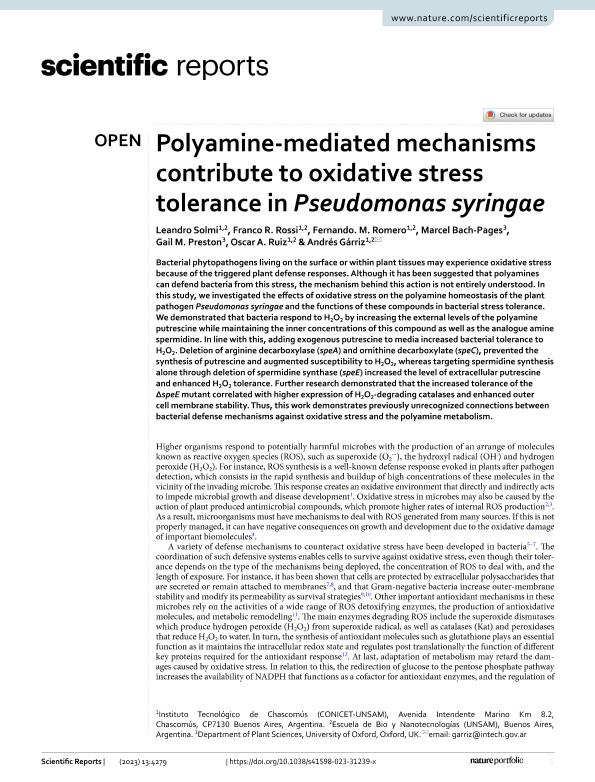Mostrar el registro sencillo del ítem
dc.contributor.author
Solmi, Leandro

dc.contributor.author
Rossi, Franco Rubén

dc.contributor.author
Romero, Fernando Matias

dc.contributor.author
Bach Pages, Marcel
dc.contributor.author
Preston, Gail M.
dc.contributor.author
Ruiz, Oscar Adolfo

dc.contributor.author
Gárriz, Andrés

dc.date.available
2023-12-28T15:53:40Z
dc.date.issued
2023-12
dc.identifier.citation
Solmi, Leandro; Rossi, Franco Rubén; Romero, Fernando Matias; Bach Pages, Marcel; Preston, Gail M.; et al.; Polyamine-mediated mechanisms contribute to oxidative stress tolerance in Pseudomonas syringae; Nature Research; Scientific Reports; 13; 1; 12-2023; 1-16
dc.identifier.uri
http://hdl.handle.net/11336/221819
dc.description.abstract
Bacterial phytopathogens living on the surface or within plant tissues may experience oxidative stress because of the triggered plant defense responses. Although it has been suggested that polyamines can defend bacteria from this stress, the mechanism behind this action is not entirely understood. In this study, we investigated the effects of oxidative stress on the polyamine homeostasis of the plant pathogen Pseudomonas syringae and the functions of these compounds in bacterial stress tolerance. We demonstrated that bacteria respond to H2O2 by increasing the external levels of the polyamine putrescine while maintaining the inner concentrations of this compound as well as the analogue amine spermidine. In line with this, adding exogenous putrescine to media increased bacterial tolerance to H2O2. Deletion of arginine decarboxylase (speA) and ornithine decarboxylate (speC), prevented the synthesis of putrescine and augmented susceptibility to H2O2, whereas targeting spermidine synthesis alone through deletion of spermidine synthase (speE) increased the level of extracellular putrescine and enhanced H2O2 tolerance. Further research demonstrated that the increased tolerance of the ΔspeE mutant correlated with higher expression of H2O2-degrading catalases and enhanced outer cell membrane stability. Thus, this work demonstrates previously unrecognized connections between bacterial defense mechanisms against oxidative stress and the polyamine metabolism.
dc.format
application/pdf
dc.language.iso
eng
dc.publisher
Nature Research
dc.rights
info:eu-repo/semantics/openAccess
dc.rights.uri
https://creativecommons.org/licenses/by/2.5/ar/
dc.subject
Pseudomonas syringae
dc.subject
Polyamine
dc.subject
Oxidative Stress
dc.subject
Hydroxy Peroxide
dc.subject.classification
Biología Celular, Microbiología

dc.subject.classification
Ciencias Biológicas

dc.subject.classification
CIENCIAS NATURALES Y EXACTAS

dc.title
Polyamine-mediated mechanisms contribute to oxidative stress tolerance in Pseudomonas syringae
dc.type
info:eu-repo/semantics/article
dc.type
info:ar-repo/semantics/artículo
dc.type
info:eu-repo/semantics/publishedVersion
dc.date.updated
2023-12-27T17:41:29Z
dc.identifier.eissn
2045-2322
dc.journal.volume
13
dc.journal.number
1
dc.journal.pagination
1-16
dc.journal.pais
Reino Unido

dc.journal.ciudad
Londres
dc.description.fil
Fil: Solmi, Leandro. Consejo Nacional de Investigaciones Científicas y Técnicas. Centro Científico Tecnológico Conicet - La Plata. Instituto de Investigaciones Biotecnológicas. Instituto de Investigaciones Biotecnológicas "Dr. Raúl Alfonsín" (sede Chascomús). Universidad Nacional de San Martín. Instituto de Investigaciones Biotecnológicas. Instituto de Investigaciones Biotecnológicas "Dr. Raúl Alfonsín" (sede Chascomús); Argentina
dc.description.fil
Fil: Rossi, Franco Rubén. Consejo Nacional de Investigaciones Científicas y Técnicas. Centro Científico Tecnológico Conicet - La Plata. Instituto de Investigaciones Biotecnológicas. Instituto de Investigaciones Biotecnológicas "Dr. Raúl Alfonsín" (sede Chascomús). Universidad Nacional de San Martín. Instituto de Investigaciones Biotecnológicas. Instituto de Investigaciones Biotecnológicas "Dr. Raúl Alfonsín" (sede Chascomús); Argentina
dc.description.fil
Fil: Romero, Fernando Matias. Consejo Nacional de Investigaciones Científicas y Técnicas. Centro Científico Tecnológico Conicet - La Plata. Instituto de Investigaciones Biotecnológicas. Instituto de Investigaciones Biotecnológicas "Dr. Raúl Alfonsín" (sede Chascomús). Universidad Nacional de San Martín. Instituto de Investigaciones Biotecnológicas. Instituto de Investigaciones Biotecnológicas "Dr. Raúl Alfonsín" (sede Chascomús); Argentina
dc.description.fil
Fil: Bach Pages, Marcel. University of Oxford; Reino Unido
dc.description.fil
Fil: Preston, Gail M.. University of Oxford; Reino Unido
dc.description.fil
Fil: Ruiz, Oscar Adolfo. Consejo Nacional de Investigaciones Científicas y Técnicas. Centro Científico Tecnológico Conicet - La Plata. Instituto de Investigaciones Biotecnológicas. Instituto de Investigaciones Biotecnológicas "Dr. Raúl Alfonsín" (sede Chascomús). Universidad Nacional de San Martín. Instituto de Investigaciones Biotecnológicas. Instituto de Investigaciones Biotecnológicas "Dr. Raúl Alfonsín" (sede Chascomús); Argentina
dc.description.fil
Fil: Gárriz, Andrés. Consejo Nacional de Investigaciones Científicas y Técnicas. Centro Científico Tecnológico Conicet - La Plata. Instituto de Investigaciones Biotecnológicas. Instituto de Investigaciones Biotecnológicas "Dr. Raúl Alfonsín" (sede Chascomús). Universidad Nacional de San Martín. Instituto de Investigaciones Biotecnológicas. Instituto de Investigaciones Biotecnológicas "Dr. Raúl Alfonsín" (sede Chascomús); Argentina
dc.journal.title
Scientific Reports
dc.relation.alternativeid
info:eu-repo/semantics/altIdentifier/url/https://www.nature.com/articles/s41598-023-31239-x
dc.relation.alternativeid
info:eu-repo/semantics/altIdentifier/doi/http://dx.doi.org/10.1038/s41598-023-31239-x
Archivos asociados
